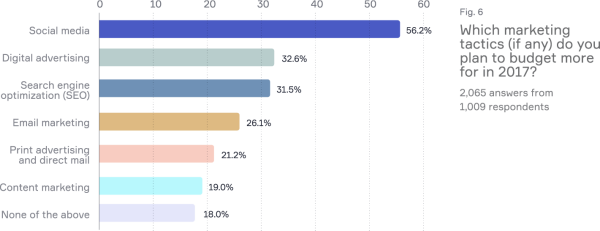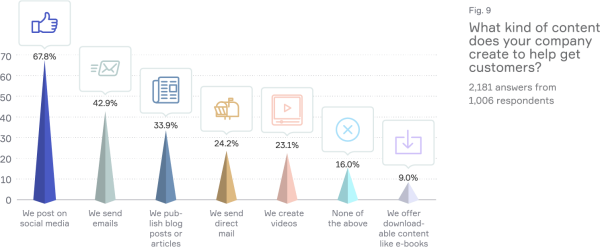Overall, digital marketing tactics remain underutilized—and misunderstood—amongst many small business owners. Given the lack of attention to measurable marketing tactics, it’s perhaps not surprising that nearly half of respondents said they don’t know if their marketing efforts are effective.
In a world where commerce and conversation will only continue to move more online, small businesses have many opportunities to adopt digital marketing tactics like marketing automation, social media, content marketing, SEO, video marketing, and digital advertising.
We asked experts from six leading organizations representing those tactics—Keap, Buffer, Content Marketing Institute, Moz, Wistia, and Aimclear—to discuss how digital marketing will evolve in 2017 and what small businesses can do to compete and succeed.
Marketing automation: Create more connection in less time

Whether they realize it or not, all small business owners are probably familiar with marketing automation. When yoxu receive an email confirmation immediately after registering for an event online or a personalized email suggesting products based on your last purchase, automation is behind the magic.
But many small business owners don’t realize that the same technology used by large corporations is also available to them, said Doug Sechrist, vice president of demand generation at Keap, which offers small business software that combines marketing automation, customer relationship management (CRM), and e-commerce tools into an all-in-one-platform.
Automation can optimize and streamline every stage of the sales funnel, from collecting contact information from leads to closing sales to asking for referrals and upsells. Software can automatically send relevant emails throughout the sales process until leads are ready to buy, helping businesses with their top goal (driving sales) and oneof their top challenges (converting leads into clients). When integrated with a CRM, automation allows you to personalize your communication with clients, sending emails based on actions they take and links they click.
Our survey suggested that small businesses are investing heavily in tactics that can help them create awareness at the top of the sales funnel, like Facebook, and not in tactics that can help them nurture leads and close sales. Only 11 percent of the small business owners we surveyed said they use automation in their marketing, and only one- quarter use a CRM tool.
While the possibilities of automation are infinite, Sechrist said small businesses can start to see results simply by automating follow-up communication. Instead of having to remember to send check-in emails to a lead who isn’t ready to buy, the software can automatically do so for you over weeks and months, ensuring you stay in touch and don’t lose track of the lead.
“You’re creating a connection you didn’t have before,” Sechrist said. “You’re showing them that you care, that you’re thinking about them, that you’re invested in them as a client.”
In 2017 and beyond, automation will only become more engrained in all areas of business. For small businesses bogged down by manual communication and processes, automation is essential to their growth, Sechrist said.
“Whether it’s automating social media, whether it’s email, whether it’s automating your phone system, automation creates efficiencies across businesses,” Sechrist said. “It allows you to do things you weren’t able to do with your current team.”
Email marketing: Make personalized messages the priority
More than 20 years after consumers started hearing “you’ve got mail,” email marketing remains the No. 1 way to reach clients. Marketers at companies of all sizes consider email marketing the most effective tactic for driving awareness, customer acquisition, conversion, and client retention, according to Gigaom Research. But the popularity of email marketing is also the problem.
“The challenge with email today is we get so much of it,” said Doug Sechrist, vice president of demand generation at Keap. “We don’t look at it; we don’t respond to it unless we know who it’s coming from and we trust the source, or there’s something extremely personal and catchy about the subject line.”
Only 44 percent of the small business owners we surveyed plan to use email marketing in 2017. But simply sending more email isn’t necessarily the goal, Sechrist said. Rather, small businesses should aim to tailor their email marketing to specific clients and their stages in the buying process. Clients are more likely to open, read, and click emails if the messages feel relevant to their needs and interests.
“If you’re sending a generic email to everyone and you’re not targeting different types of people, you’re probably not going to get the results you’re looking for,” Sechrist said.
With software like Keap, you can send more targeted email by segmenting contacts based on criteria like demographics, interests, and purchase behavior. You can also set up automated sequences that trigger emails when clients take actions like clicking on a link, ensuring they get the right information at the right time.
Social media: Fight the drop in organic reach
More than 1.8 billion people worldwide are active on Facebook, and so are 72 percent of the small business owners we surveyed. But small business owners may not realize that simply posting on Facebook doesn't work like it used to.
With Facebook growing more crowded and its algorithm favoring content from advertisers and friends, businesses have seen the organic reach of their posts drop dramatically in recent years. The average post reaches less than 10 percent of followers and engages only four percent of them, according to a study by Locowise.
“If you’re not going to create enough content or curate enough content, you’re not going to see results from social media, unfortunately,” said Brian Peters, social media manager at Buffer, a social media management platform. “There’s just too much content on Facebook.”
To continue connecting with clients on social media, small business owners need to change their habits, Peters said. Business owners should make social media part of their daily routines, even if they dedicate only 20 minutes a day, and consider using a social media management tool to schedule content in advance.
Businesses can increase their Facebook content production (and therefore, their chances for visibility) by curating content from news outlets and organizations, Peters said. Sharing posts that are interesting to your audience, even if they don’t directly relate to your offerings, helps your business stay top-of-mind.
Less than half of the small business owners we surveyed use social platforms other than Facebook. Whether that means they’re missing opportunities depends on the business, Peters said: Snapchat might be essential if you market to 20-somethings, but not if your target clients are their parents.
“Only be on the platforms that your audience is on,” Peters said. “Most of the time, that means Facebook, Instagram, and Twitter. For a small business owner who has limited resources, those are the platforms that can actually drive bottom-line results.”
To grow leads and sales from social media, small businesses need to consider advertising. With advanced advertising options that allow businesses to target users based on specific interests, behaviors or even their email addresses, Facebook, Instagram, and Twitter are most likely to help small businesses find the right followers and, ultimately, clients.
In 2017 and beyond, small businesses will be able to experiment on a growing number of social platforms, like Facebook Live and Instagram Stories (which also now has a live video feature). Peters encourages small business owners to stake out a place on the platform that’s best for their audience—while being aware that doing so may come at a price.
“Organic reach is going to continue to drop, which means we’re going to see an increase in advertising,” Peters said. “Small businesses need to get creative and find ways to reach audiences with less budget.”
Content marketing: Help leads learn before they buy
Before they buy, most consumers don’t pick up the phone and call your company. First, they do research on their own: According to the technology company CEB (now Gartner), B2B buyers are 57 percent through their decision-makingprocess by the time they engage with a sales rep. That’s why across industries, companies are shifting away from cold pitches and toward content marketing, producing blog posts, videos, and other content that helps leads learn before they buy.
In a study by Content Marketing Institute and MarketingProfs, 89 percent of business-to-business marketers and 86 percent of business-to-consumer marketers are using content marketing in 2017. For both groups, 70 percent or more said their content marketing is moderately, very, or extremely successful.
Small businesses are behind the curve, with just 27 percent of our survey respondents planning to use content marketing in 2017 (although, in a different response, 34 percent said they publish blog posts and articles).
Aside from finding time and resources for content marketing—a challenge at companies of all sizes—small business owners often struggle to develop a strategy behind their content, said Joe Pulizzi, founder of Content Marketing Institute. He emphasizes that content marketing builds trust and loyalty over time, not necessarily as soon as your new blog post is published.
“For content marketing to work, you need an audience—even an audience of one—and you need to deliver a helpful message on a consistent basis. That’s it,” Pulizzi said. “The challenge is it usually takes over nine months to start seeing results. Most small businesses are not that patient.”
A small business with no marketing employees and a limited budget isn’t likely to start churning out daily blog posts, videos, and social posts for every platform. Pulizzi’s advice: Start small, identifying your target audience and how content can address their needs and questions. Then choose one content type, whether it’s an article, video, or podcast, and create it consistently.
A key to success with content, Pulizzi said, is having a list of email subscribers to consume it. That’s where other tools like marketing automation come into play, helping businesses collect leads through content and distributing content at relevant times in the buyer’s journey. One of the best ways to build an email list is by collecting contact information in exchange for a piece of downloadable content—a strategy used by only nine percent of survey respondents.
“Those who dabble in content marketing don’t understand the strategy and don’t see how big an opportunity it really is,” Pulizzi said. “Now is the first time ever that small businesses can, through content, build an audience that knows, likes, and trusts them.”
Search engine optimization: Be found where people are searching
When people are searching online for products or services like yours, it’s imperative that your business pop up in the search results. That’s what search engine optimization is all about.
Yet 60 percent of the small business owners we surveyed said they won’t be using SEO tactics in 2017.
The study of SEO is never-ending, with Google using more than 200 factors to determine which content gets Page 1 real estate in search results. But there are also simple ways for small businesses to improve their search rankings, said Britney Muller, SEO and content architect at Moz, which offers SEO software and resources.
Muller suggests small businesses start by focusing on online business directories and review sites, both of which provide valuable links to your site and tell search engines—and potential clients—that your business is legitimate.
Add your business to directories like Google My Business and Bing Places for Business, ensuring information is consistent and adding photos where possible. Ask clients to review your business on sites like Google and Yelp: Not only are reviews read by 92 percent of consumers, they also boost the standing of your site in search rankings.
But perhaps the greatest key to SEO, Muller said, is content that creates entry points to your website through search results. When you identify keywords that people use to look for your business—ideally, those with a high number of searches and low amount of competition—you can create content that draws them in by answering their questions. If you don’t know what kind of content to produce, start by doing some Googling yourself, Muller said.
“Take a look at what your competitors have produced that’s ranking really well,” she said. “You just need to create something a little better. A lot of times, it’s not that hard—it’s taking the great content that’s already there and making it your own.”
The world of SEO gets far more technical, with Muller naming accelerated mobile pages and progressive web apps as top advanced SEO trends for 2017. But small businesses can help more clients find them with even basic SEO, like using a good keyword in the title of each webpage.
“Understanding the market and how people are searching and what questions they have is so incredibly powerful,” Muller said. “You are the expert. To be able to provide that expertise (through content and SEO) while invoking trust and third-party credibility is a home run.”
Video marketing: Get started—no experience or budget necessary
Our survey revealed a sizeable rift between small business marketing tactics and a major digital marketing trend for the future: video.
According to Cisco, 82 percent of internet traffic will stem from video by 2020. But most small businesses aren’t part of the trend: Only 23 percent of small businesses we surveyed create video to attract clients, making video slightly less popular than direct mail (used by 24 percent of respondents).
Video marketing sounds intimidating, but it’s achievable for small business owners with limited experience, time and budget, said Jordan Wellin, content creator at the video hosting and analytics platform Wistia.
“You don’t need professional skills in video; you don’t need a huge budget,” he said. “Do you have an iPhone? Well, then you can do this. Honestly, you can.”
Video stands out as an engaging and authentic way to connect with clients. In fact, four times as many as consumers prefer video to reading about a product.
Small businesses can create videos that showcase products, share a tutorial or expertise, or simply offer a glimpse at you, your staff, and your office. Video can be integrated into the rest of your marketing strategy, from your social media posts to your blog to your emails. To get started, you don’t need much more than your phone, a tripod, a backdrop, and a lighting kit that costs less than $100.
Video can increase engagement on social media and drive more traffic to your website through SEO and YouTube. But small businesses don’t need to worry about reaching thousands of viewers with video, Wellin said.
Video can be just as effective if aimed at an audience of one. Wellin anticipates more businesses creating the video equivalent of voicemails, whether to answer a lead’s question in a more personal way or to thank a new client by name.
“You’re fighting against so many competitors that you can get lost in the noise. Video humanizes what it is you’re doing,” Wellin said. “It makes your story real and tangible.”
To take video to the next level, Wellin said, use it to capture leads. Platforms like Wistia allow you to collect email addresses mid-video, allowing you to follow up with additional information. With less than 13 percent of survey respondents saying they use content to collect leads, small businesses stand out over the competition by creating video that results in not only views, but action.
Digital advertising: Start small, but be precise
Not long ago, advertising meant placing your company’s message in print, in a TV commercial, or on a billboard and hoping it reached your target audience (along with everyone else). And that also meant it was largely unaffordable for small businesses.
Now that small businesses can target specific audiences and search queries online, advertising has become far more precise, cost-effective, and measurable. Instead of asking clients “How’d you hear about us?”, businesses can determine which ads worked best by correlating clicks to leads and sales.
But the majority of small business owners we surveyed aren’t using digital advertising tactics through search engines like Google and social networks like Facebook. Forty-two percent plan to advertise online in 2017, while only one-third plan to invest more in digital ads.
Many small business owners assume that digital advertising is too complex or too costly. And it can be if you’re spending ad dollars on the wrong keywords for Google AdWords or the wrong audience on Facebook, said Manny Rivas, chief marketing officer at Aimclear, a digital marketing agency specializing in audience targeting and client acquisition.
“On a small budget, you have to be extremely precise in where the investment goes,” he said. “Before any dollar is spent, it’s imperative to confirm that all the data can be tracked, attributed, and assigned a value against cost.”
Any digital ad should connect to a business goal, whether it’s capturing email addresses from leads or driving sales of a specific product. Without goals and the ability to track lead sources through tools like Google Analytics or a CRM like Keap, business owners can’t determine whether their marketing efforts are effective (a problem for nearly half of survey respondents).
Once you have metrics to compare, don’t feel obligated to invest evenly across advertising tactics, Rivas said. If you find that a single Google keyword drives the majority of your leads, focus your budget there, rather than spreading it across several keywords.
Before starting with digital advertising, small business owners should understand the online habits of their audience, Rivas said. By studying the terms people use in search engine queries, you can create ads that answer those questions. By understanding the demographics, interests, and behaviors of your clients, you can create custom and lookalike audiences to target only people likely to be interested in your company—not everyone, like in the billboard days.
“[Digital advertising] doesn’t always need to be complex, but you do need a vision for what you’re trying to achieve,” Rivas said. “The mechanisms to drive business results can be straightforward if you understand where your audience is, who your audience is, and how they consume content and search for answers.”
Try free
14-day free trial. No credit card required.













